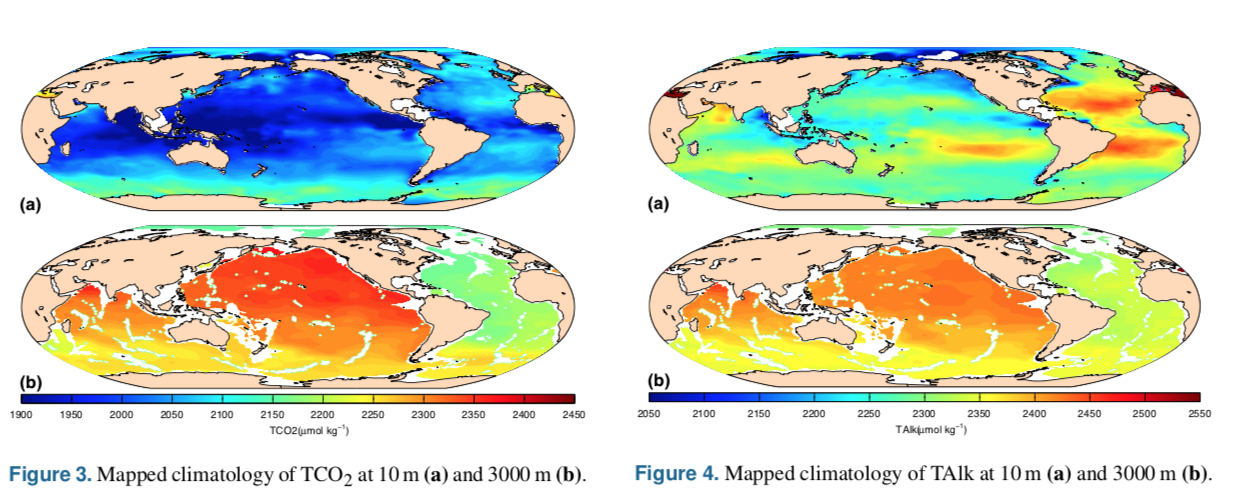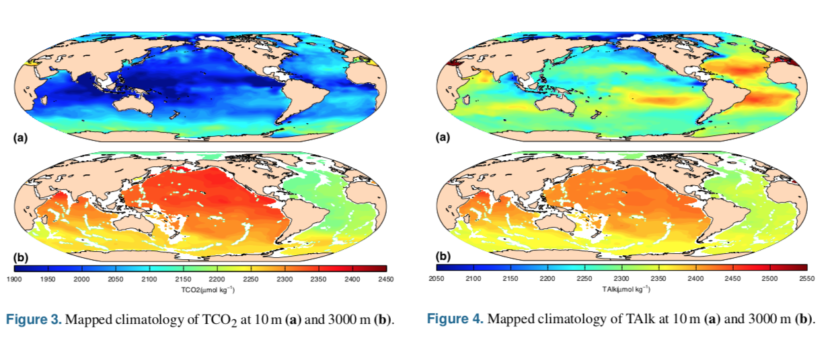For the Global Ocean Data Analysis Project (GLODAP) extensive quality control and subsequent calibration were carried out for salinity, oxygen, nutrient, carbon dioxide, total alkalinity, pH and chlorofluorocarbon data. Data from approximately one million individual seawater samples were collected from almost 800 cruises carried during the years 1972-2013. The data were used to produce global climatology maps for many of the parameters.
DESCRIPTORS
type
observations (interpolated)
gridded
yes
formats
nc, mat, csv, odv
TEMPORAL
period
present
coverage
1972–2013 (used for climatologies)
resolution
annual
climatology
yes
SPATIAL
coverage
global, regional
resolution
1° by 1°
depth
depth resolved (33 levels between 0 m and 5500 m)

MAJOR VARIABLES
calcium carbonate saturation state (1)
carbon tetrachloride (ccl4) (1)
dichlorodifluoromethane (cfc-12) (1)
dissolved oxygen (o2) (2)
nitrate (no3) (2)
pH (1)
phosphate (po4) (2)
salinity (2)
silicate (sio2) (2)
temperature (3)
total alkalinity (talk) (1)
total dissolved inorganic carbon (tco2) (1)
trichlorofluoromethane (cfc-11) (1)
trichlorotrifluoroethane (cfc-113) (1)
KEY REFERENCES
- Lauvset, S. K, R. M. Key, A. Olsen, S. van Heuven, A. Velo, X. Lin, C. Schirnick, A. Kozyr, T. Tanhua, M. Hoppema, S. Jutterström, R. Steinfeldt, E. Jeansson, M. Ishii, F. F. Pérez, T. Suzuki and S. Watelet (2016). A new global interior ocean mapped climatology: the 1°x1° GLODAP version 2, Earth Syst. Sci. Data, 8, 325–340, doi:10.5194/essd-8-325-2016.
- Olsen, A., R. M. Key, S. van Heuven, S. K. Lauvset, A. Velo, X. Lin, C. Schirnick, A. Kozyr, T. Tanhua, M. Hoppema, S. Jutterström, R. Steinfeldt, E. Jeansson, M. Ishii, F. F. Pérez and T. Suzuki. The Global Ocean Data Analysis Project version 2 (GLODAPv2) – an internally consistent data product for the world ocean, Earth Syst. Sci. Data, 8, 297–323, 2016, doi:10.5194/essd-8-297-2016.
MORE INFORMATION
- The following GLODAPv2 variables were used to produce climatologies: salinity, temperature, oxygen, nitrate, phosphate, silicate, total dissolved inorganic carbon (TCO2), total alkalinity (TAlk), pH, and CaCO3 saturation states (see Lauvset et al., 2016).


